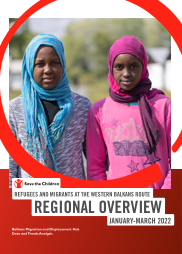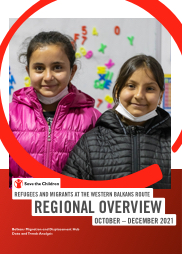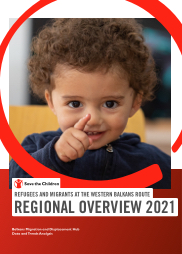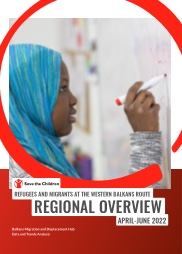
Briefs, Fact Sheets and Brochures, Reports
Balkans Migration and Displacement Hub Data and Trend Analysis: Regional Overview January-March 2022
Publication year:
2022
English
Format:
PDF (1.6 MiB)
Publisher:
Save the Children North West Balkans
Data and Trend Analysis (DATA) Refugees and Migrants at the Western Balkans Route Regional Overview January-March 2022 describes key trends in migrations in the region, detailing information about the number of people on the move, demography (age, sex, country of origin, etc), behavioral patterns, and routes in use – with a focus on children, particularly unaccompanied children.
Key trends showcased in this report:
- The Western Balkans mixed migration route was the most active pathway to Europe at the beginning of 2022. The route accounted for almost half of all arrivals in the first three months of 2022, most of whom were persons fleeing Syria and Afghanistan.
- The war in Ukraine also pushed millions of people to flee, and they constituted a large number of arrivals in most countries on the Balkans Route. They usually arrived in a regular manner and stayed in the countries in the Balkans region as tourists, as no visas were required for visits of up to 90 days, depending on the country. Some applied for asylum, while the majority benefited from the temporary protection status swiftly made available in most countries.
- Romania recorded the most newly arrived refugees and migrants in the first three months of the year (5,843), while Kosovo* and Montenegro reported the least arrivals on the route.
- Despite an increase in detected irregular arrivals, there was no increase in those who stayed in the Balkans.
- By the end of the reporting period, only 7,758 refugees and migrants, excluding those from Ukraine, reportedly remained in the Western Balkans, mainly in Serbia (63%) and Bosnia and Herzegovina (29%).
- The data suggest two conclusions: the countries on the route remained transit corridors towards Western and Northern Europe, and the movements continued to be swift despite tightened border controls.
- Allegations of arbitrary expulsions continued to be documented throughout the region. Regional watchdog coalitions have pointed out the systemic nature of these unlawful border control and deterrence measures that deny hundreds of people access to asylum and other rights. On Serbia’s external borders only, the UNHCR collected evidence of 2,479 arbitrary expulsions in the first three months of 2022, predominantly from Hungary (82%) and Romania (12%).
Read full abstract
Authors
View & Download
Document information
Publisher
Authors
Format
Content type
Country
Region
Topics
Rights
© Author/Publisher
Found a mistake? Help us improve!
If you have noticed a document assigned to the wrong author or any other inaccuracies, let us know! Your feedback helps us keep our data accurate and useful for everyone.
Related Documents
Share
Link




